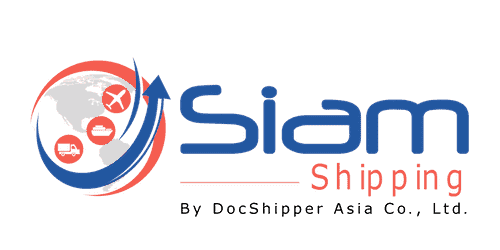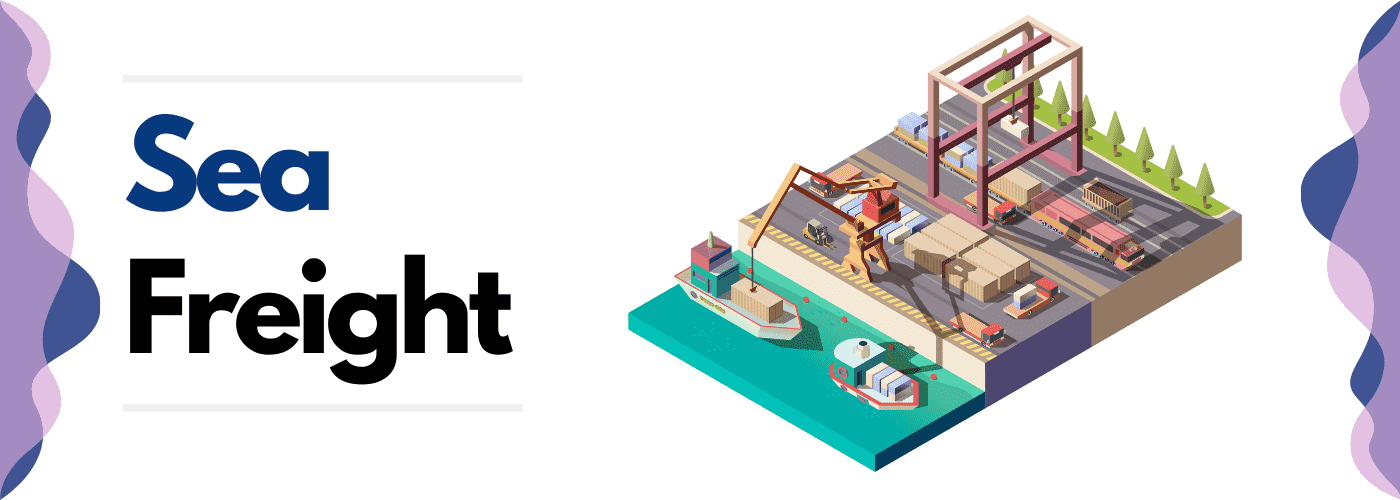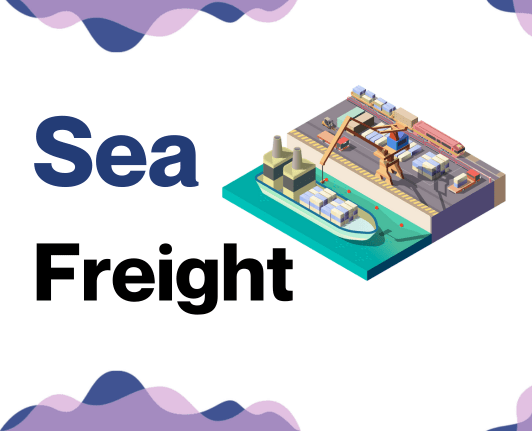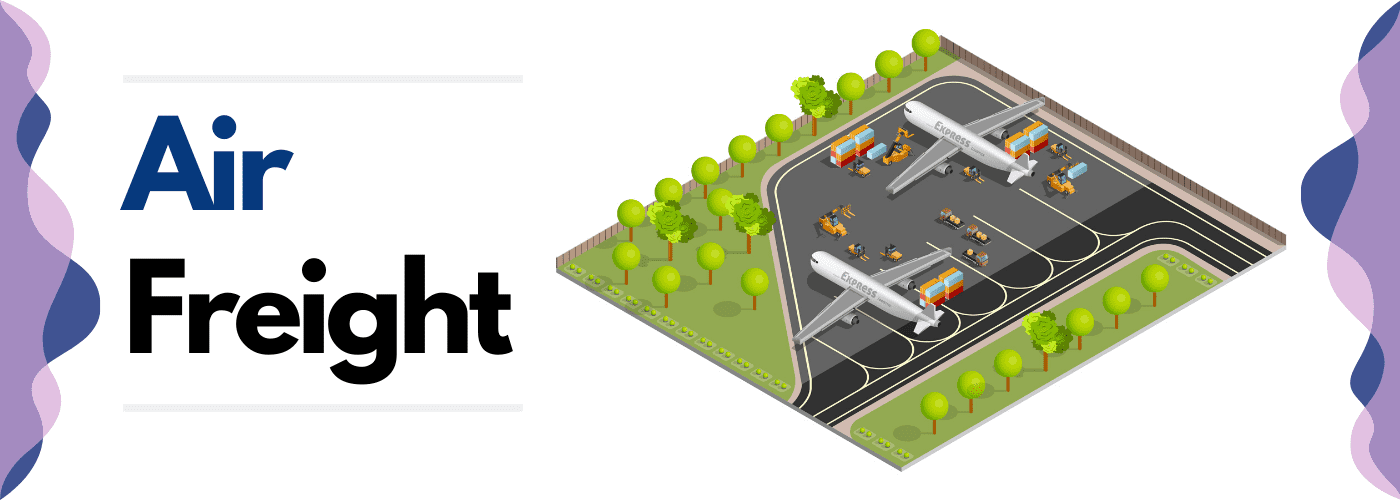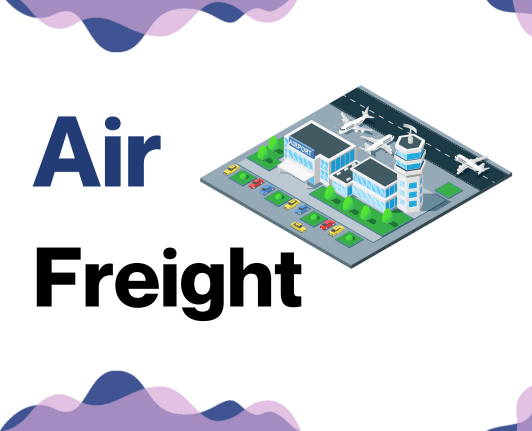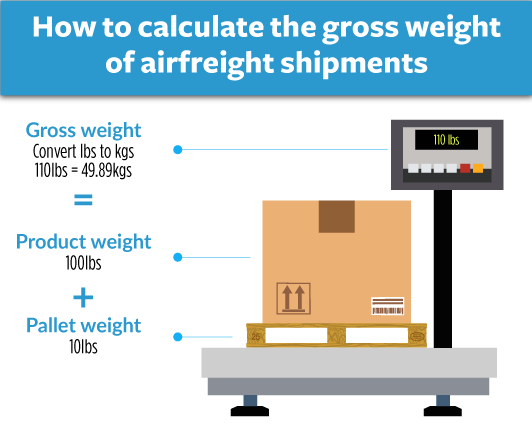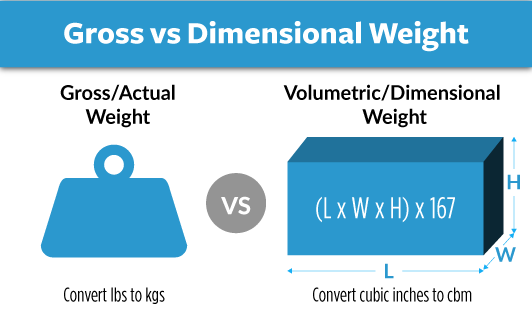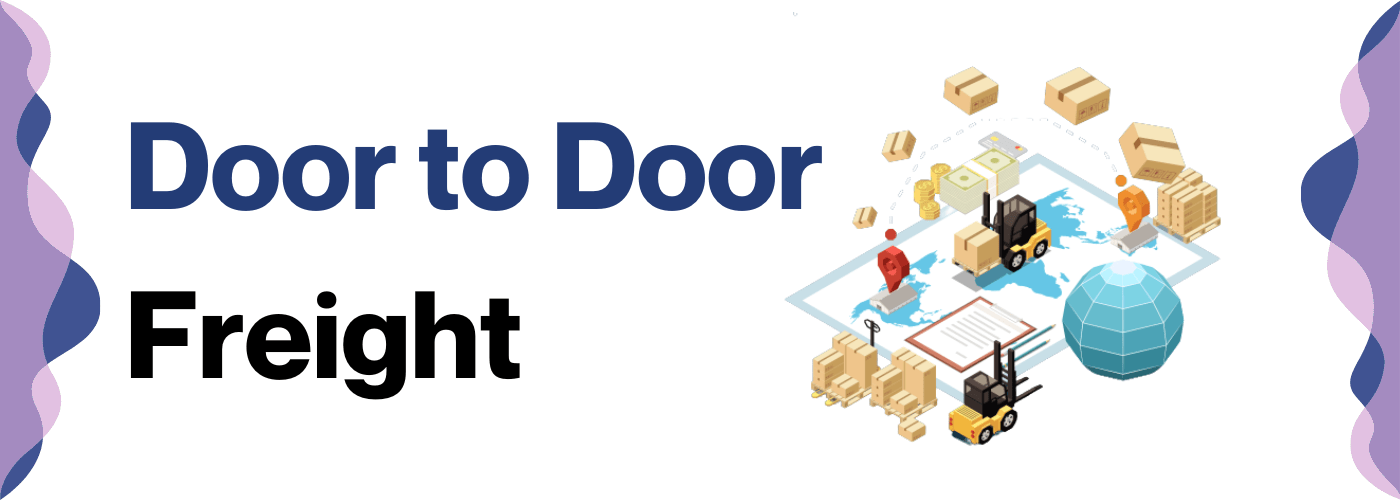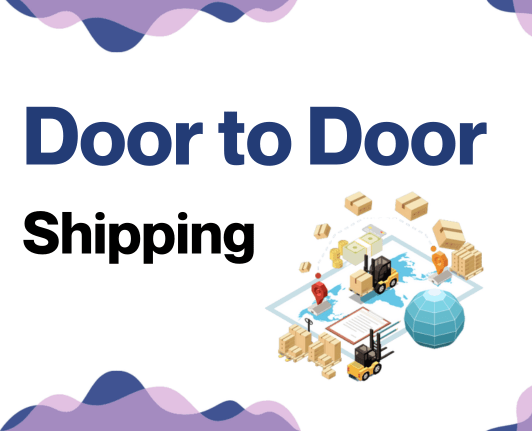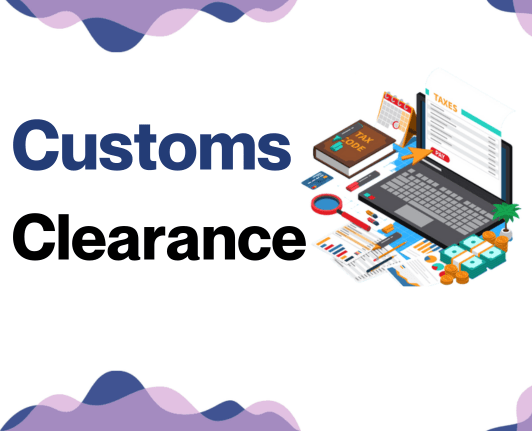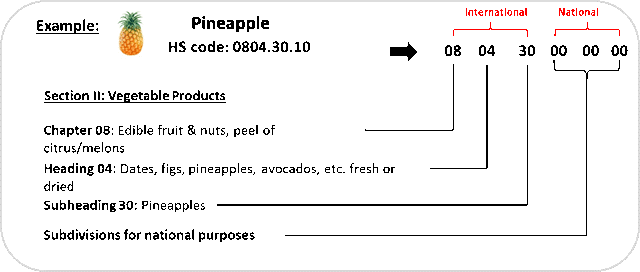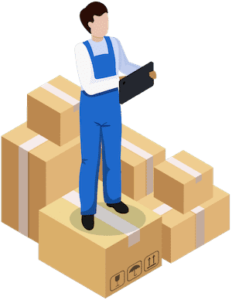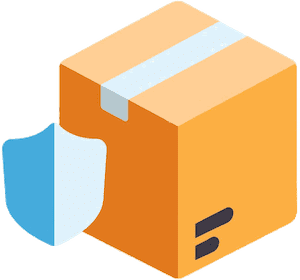Shipping goods from Switzerland to Thailand can be complex, with freight rates, transit times, and customs regulations often creating more questions than answers.
This guide is here to make the process easier for you. We’ll walk you through everything, from choosing the best mode of transport—whether it’s air, sea, rail, or road freight—to navigating customs clearance, duties, and taxes. You'll also find practical tips to help you manage each step of your shipping journey.
And if it still feels overwhelming, DocShipper is ready to step in. As an international freight forwarder, we take care of all the details, so you can focus on what you do best—growing your business.
Which are the different modes of transportation between Thailand and Switzerland?
Remarkably, Switzerland and Thailand are 9000km apart, with several countries in between. This distance challenges the idea of road or rail transport. Your three main contenders here are air, sea, and rail through several transitions. The best method? It depends! Quicker but costlier, a jet could whisk your goods from Bangkok to Zurich. If you're not in a hurry, a ship cruising the Arabian Sea might be your wallet's friend. Alternatively, rail traversing continents is a thrilling odyssey. Imagine your goods as a protagonist in a 'Planes, Trains and Automobiles' kind of tale. Take your pick, considering your timeline, budget, and product delicacy!
How can Siam Shipping help?
Facing obstacles with shipping between Thailand and Switzerland? DocShipper is here to simplify your journey. Our experts handle all aspects - from transportation organization, customs clearance, to administrative hassles, ensuring your goods reach safely. Want a seamless shipping experience? Contact us for a free estimate within 24 hours or call our consultants for any queries.
Siam Shipping Tip: Consider ocean freight if:
- You are shipping large volumes or bulky items, as sea freight offers the most space at a cost-effective rate.
- You're not racing against the clock. Ocean freight takes its sweet time, especially when stacked up against other transport methods.
- Your supply chain is linked up with big-name ports. Think of it as the VIP lane on the maritime superhighway.
Sea freight between Thailand and Switzerland
Jumping straight into it, the Thailand-Switzerland trade connection is an intriguing one, with bustling ports like Laem Chabang and Bangkok in Thailand and Basel in Switzerland creating a bustling trade bridge. Ocean shipping presents a virtually unbeatable solution for large, bulky shipments - think of it as packing the entire contents of a warehouse onto a single boat. Yeah, it's not the hare in our race, but as the proverbial tortoise, it packs a serious cost-effective punch.
Speaking of boxing, imagine stepping into a ring without knowing the rules. You'd get floored, right? That's similar to what businesses often experience while shipping between these two vibrant economies. From wrapping your head around tricky customs regulations to the ever-shifting landscape of freight fares, it can feel like trying to solve a Rubik's cube in the dark.
But fear not! In this guide, we'll reveal tried-and-tested practices to illuminate this process, saving you from common rookie errors. We’ve got your back!
Main shipping ports in Thailand
Laem Chabang:
Location and Volume: Situated in Chonburi Province, this port is a crucial hub for Thailand due to its proximity to the highly urbanized areas of Bangkok and Pattaya. with ongoing developments expected to increase this capacity to 18 million TEUs by 2025.
Key Trading Partners and Strategic Importance: Trading partners include China, United States, and Japan. It is the busiest container port in Thailand and one of the busiest in the world.
Context for Businesses: If you're exploring expansion in Asian markets, notably China, stepping up your usage of Laem Chabang could pay off due to its significant container handling capacity and robust links to important markets.
Bangkok Port:
Location and Volume: Located in Bangkok, this port is essential for urban-focused trade, with a shipping volume of more than 600,000 TEUs.
Key Trading Partners and Strategic Importance: Mainly trading with neighboring Asian countries such as China, Japan, and Singapore. Bangkok Port holds a strategic location that facilitates easy access to the capital city's market.
Context for Businesses: If you are considering penetration into Bangkok's dense market, Bangkok Port can be an effective choice due to its prime location and accessibility.
Map Ta Phut:
Location and Volume: Situated in Rayong, this port is significant for handling chemical and natural gas products, having an annual trade volume of around 25 million metric tons.
Key Trading Partners and Strategic Importance: Deals mostly with Japan, Indonesia, and Qatar. The port is a significant player for energy companies due to its focus on gas and chemical product handling.
Context for Businesses: If your focus is on energy resources trade, Map Ta Phut's specialization in this sector might align well with your shipping strategy.
Songkhla:
Location and Volume: Located on the southern coast of Thailand bordering the Gulf of Thailand, Songkhla offered services to around 13,000 vessels in a recent report. handles approximately 600,000 tons of cargo annually
Key Trading Partners and Strategic Importance: Malaysia and Singapore are key trade partners. Songkhla is a crucial port for accessing the markets of Southeast Asia.
Context for Businesses: If you want to create a foothold in the Southeast Asia market, using Songkhla for your logistics need due to its nearness and links to this region could be beneficial.
Sattahip:
Location and Volume: It’s located in the eastern part of the country in Chonburi Province and is primarily a naval port with some commercial traffic with an annual cargo volume of around 300,000 TEUs
Key Trading Partners and Strategic Importance: Handles goods to and from nearby Asian nations. Its strategic importance lies in military logistics.
Context for Businesses: If you're working on a project requiring military logistic support, Sattahip might fit into your shipping strategy given its function as a naval port.
Phuket Port:
Location and Volume: Located on the island of Phuket, this port is crucial for passenger services and some commercial goods with an annual cargo volume of around 1 million TEUs.
Key Trading Partners and Strategic Importance: Important partners include China and Australia. Its strategic importance centers around tourism and providing gateway to Thailand's southern islands.
Context for Businesses: If your business involves tourism, passenger transport, or specific types of regional trade, the Phuket port may be an important asset in your logistics.
Main shipping ports in Switzerland
Location and Volume: Located in the heart of Europe, the only commercial port in Switzerland, Port of Basel, is a fundamental nodal point for pan-European trade. Its strategic location plays a crucial role in consolidating connections between the North Sea and the Mediterranean. The port boasts an annual shipping volume of approximately 7 million tonnes.
Key Trading Partners and Strategic Importance: The Port of Basel has robust links with key global players such as Germany, France, Netherlands, USA, and China. This port anchors its strategic importance in its position at the crossroads of three exceptionally significant freight lines: Rhine, Alpine, and Danube.
Context for Businesses: If your enterprise targets a wider European market and requires rapid, efficient connections, integrating Port of Basel into your logistics strategy could be beneficial. Its advantageous location and vast network of transportation methods streamlines your shipping process, potentially leading to cost savings and improved delivery timings.
Please note, while Switzerland is a landlocked country, its well-developed railway network and critical position in central Europe make it a crucial hub in international rail freight logistics. This, combined with river ports along the Rhine like the Port of Basel, enables Switzerland to play a vital role in the global supply chain. This detailed information should underline the importance of including Switzerland in your global supply chain strategy, even without traditional sea ports.
Should I choose FCL or LCL when shipping between Thailand and Switzerland?
Deciding between Full Container Load (FCL) and Less than Container Load (consolidation or LCL) for shipping from Thailand to Switzerland can be daunting, yet vital! It’s a high-stakes decision that directly affects your bottom line and delivery timelines. This section is your compass to navigate these waters, breaking down crucial factors like cost, time, and efficiency, enabling you to make a savvy choice that's a perfect fit for your specific business needs. Onwards to mastering maritime freight choices!
LCL: Less than Container Load
Definition: Less-than-container load (LCL) is a term used to describe the shipping of cargo that is not enough to fill a standard shipping container. It is a cost-effective strategy for low-volume shipping needs.
When to Use: LCL is best used when your freight is less than 13 to 15 cubic meters. This could be perfect for startups, small businesses, or larger businesses with lightweight products.
Example: A Thai handicraft business wanting to export eclectic home decor accessories to Switzerland may only need to ship about 10 cubic meters. LCL would be the ideal shipping option.
Cost Implications: With LCL, businesses pay only for the container space they utilize. This provides a significant cost advantage for smaller volumes. However, be aware there could be additional handling charges as your shipment will be consolidated with others, loading and unloading at different ports. Overall, LCL has a dynamic pricing model. Your lcl shipping quote or lcl freight charge can vary, but generally, it's significantly less than booking a full-container load (FCL) shipment.
FCL: Full Container Load
Definition: FCL (Full Container Load) shipping involves hiring an entire container for transporting your goods. In this case, all the cargo in the 20'ft or 40'ft container is owned by one shipper, offering greater control and security as the container is sealed from origin to destination.
When to Use: FCL shipping is typically the more cost-effective option when you've got a high volume of cargo - approximately 13 to 15 CBM or more. It’s a strong choice when safety is a priority, as the shipment remains undisturbed until it's unsealed at the destination.
Example: Let's consider a Thailand-based furniture manufacturer looking to ship a bulk order to a retailer in Switzerland. As the cargo volume exceeds 14 CBM, they decide to opt for a FCL shipping arrangement to ensure the safety of their valuable items and potentially save on shipping cost.
Cost Implications: FCL shipping quotes generally offer advantageous unit prices for larger volumes, especially compared with LCL (Less Container Load) alternatives. However, remember that while the per unit cost might be lower, the overall cost is invariably higher due to the bulk nature of the exchange. Remember, with FCL, you pay for the whole container, regardless of whether you fill it completely or not.
Unlock hassle-free shipping
Streamlining cargo shipping from Thailand to Switzerland is what DocShipper does best. Our team of ocean freight experts will guide you, whether you opt for consolidation or full container loads. Factors like your shipment size, budget, and timelines dominate the decision-making. We personalize shipping options, ensuring a hassle-free experience for your business. Don't stay in the dark about your shipping choices. Reach out to us now for a free estimation!
How long does sea freight take between Thailand and Switzerland?
On average, sea freight shipping time between Thailand and Switzerland may take anywhere from 25 to 45 days. The transit times fluctuate due to several variables such as the specific ports utilized, the weight of the shipment, and the nature of the goods being transported. If you're shipping goods and need a more precise estimate, it's advisable to connect with a reliable freight forwarder like DocShipper who can provide a customized quote tailored to your needs.
Here is the average transit times for sea freight between the main ports in Thailand and landlocked Switzerland:
| Thailand ports | Switzerland ports | Average Transit Time to Switzerland (Days) |
| Bangkok | Port of Basel | 28 |
| Laem Chabang | Port of Basel | 28 |
| Map Ta Phut | Port of Basel | 28 |
| Songkhla | Port of Basel | 27 |
*Please note: As Switzerland doesn't have its own seaport, sea freight is generally brought into ports in neighboring countries, such as Germany or the Netherlands, before being transported to Switzerland by rail or road.
How much does it cost to ship a container between Thailand and Switzerland?
Shipping a container from Thailand to Switzerland is not a fixed price game; it's a fluctuating ballpark. The shipping cost typically ranges widely per CBM due to several determining factors. Your Point of Loading and Point of Destination, the selected carrier, nature of your goods, and monthly market variations all play significant parts in the final ocean freight rates.
While we wish we could offer a one-size-fits-all price, it's simply unrealistic. Fear not, our shipping specialists crunch these variables and work diligently to provide the most competitive and accurate rates specifically tailored to your shipment. Rest assured, we quote each case uniquely, prioritizing the best for your business.
Special transportation services
Out of Gauge (OOG) Container
Definition: An OOG container is designed for items that can't fit in a normal container due to their size or shape. It includes flat racks and open top containers.
Suitable for: Larger, oversize items that won't fit into a standard container.
Examples: Industrial equipment, machinery, large vehicles, or pre-assembled goods like prefab homes.
Why it might be the best choice for you: If you need to ship unusually large or shaped items from Thailand to Switzerland, an Out of gauge cargo option can be a lifesaver.
Break Bulk
Definition: Break bulk involves shipping cargo items separately rather than in containers, essentially designed for goods that can't be containerized.
Suitable for: Varied, non-standardized cargo that's bulky and heavy.
Examples: Things like construction equipment, timbers, or metal beams. These items are typically shipped as they are, without any container.
Why it might be the best choice for you: For non-containerizable cargo, break bulk is an optimized method that provides greater flexibility in handling and loading.
Dry Bulk
Definition: Dry bulk is a shipping method where cargo typically in the form of loose cargo load is shipped in large quantities within a ship's cargo space without containment.
Suitable for: Goods that are uniformly shaped and can be easily grabbed or scooped, typically in granular form.
Examples: Raw materials such as coal, grains, or sand.
Why it might be the best choice for you: If you're shipping a large amount of granular items, like raw commodities, Dry bulk is the most efficient.
Roll-on/Roll-off (Ro-Ro)
Definition: With the Roll-on/Roll-off method, the cargo directly rolls onto the ro-ro vessel under its own power or with the help of a working machine.
Suitable for: Vehicles and heavy machinery which can be driven on and off the ship.
Examples: Cars, trucks, trailers, cranes, or any other wheeled machinery.
Why it might be the best choice for you: Going RoRo can be a fast and efficient way of shipping larger autos or machinery from Thailand to Switzerland.
Reefer Containers
Definition: Reefer containers are refrigerated containers used to ship goods that need temperature control during transportation.
Suitable for: Perishable goods such as fruits, vegetables, dairy products, pharmaceuticals, or other such temperature-controlled goods.
Examples: Thailand's exotic fruits or Swiss cheeses require temperature control to maintain their quality during the long journey.
Why it might be the best choice for you: If you're shipping goods that need a temperature-controlled environment, investing in Reefer containers can retain the quality of your goods.
For detailed advice tailored to your specific shipping needs, contact DocShipper. We'll provide you a free shipping quote in less than 24 hours.
Siam Shipping Tip: Consider Air freight if:
- Time's ticking and you can't wait. Air freight is like the express train of shipping; it's the quickest way to get your stuff from A to B.
- You're not shipping a warehouse. If your cargo is under 2 CBM, air freight is a snug fit for your smaller haul.
- Your supply chain ends somewhere off the beaten path. Airports are everywhere, so you can get your goods to those hard-to-reach spots.
Air freight between Thailand and Switzerland
If you're shipping small, high-value items from Thailand to Switzerland, air freight is your best friend. It's like using a bullet train rather than a cruiser bike, getting your goods to the destination swiftly and securely. This is especially beneficial if you're dealing with perishable goods like orchids or precision equipment – time is truly of the essence here.
But, oh boy, there's a twist! Many shippers trip over a series of pitfalls along the way. It's like walking in a maze blindfolded, making an already complex process even more challenging. Misjudging the cost based on incorrect weight calculations can be an expensive error, like ordering a meal without seeing the price and getting the shock of your life while settling the bill.
It's these details, along with other best practices, that can make all the difference in your shipping game, saving you from paying over the odds. And we'll uncover how to avoid these hurdles ahead. So, strap yourself in as we explore the nitty-gritty of air freight between Thailand and Switzerland.
Air Cargo vs Express Air Freight: How should I ship?
Selecting the best air freight method for shipping your goods from Thailand to Switzerland can feel like a real puzzle. You know air cargo places your goods on a regular airline, while express air freight whisks them away on a dedicated plane. Both have their perks, but which is tailor-made for your business needs? Let's dive into the specifics to make an informed choice.
Should I choose Air Cargo between Thailand and Switzerland?
Choosing air cargo for your Thailand-Switzerland routes could be a cost-effective and reliable option, especially when shipping goods over 100/150 kg (220/330 lbs). Popular choices include Thai Airways International and Swiss International Airlines. These airlines have fixed schedules which could lead to slightly longer transit times, but the efficiency and reliability outweigh this minor downside. Check out their services on their official websites: Thai Airways International(http://www.thaiairways.com/) and Swiss International Airlines(https://www.swiss.com/). With air cargo, your budgetary needs are bound to be met without compromising the quality of service.
Should I choose Express Air Freight between Thailand and Switzerland?
Express air freight is a standout service using specialized, cargo-exclusive aircraft designed to transport your goods swiftly and securely. If you’re shipping under 1 cubic meter or a cargo weight of 100/150 kg (220/330 lbs), this could be your best choice. Top international couriers like FedEx, UPS, and DHL offer these efficient services, ensuring rapid delivery at your doorstep. This choice delivers the lightning-speed solution your business needs to keep things moving.
Main international airports in Thailand
Suvarnabhumi Airport
Cargo Volume: Suvarnabhumi Airport, which handles over 1.4 million tons of cargo annually, is Thailand's busiest cargo airport.
Key Trading Partners: Key trading partners include China, Japan, the United States, Malaysia, and Singapore.
Strategic Importance: Located in Bangkok, this airport serves as the country's main hub for international cargo transport. With its proximity to major shipping routes, Suvarnabhumi plays a crucial role in facilitating Thailand's trade.
Notable Features: Boasts state-of-the-art facilities such as a Perishable Premium service catering to temperature-sensitive goods, a dedicated Free Zone area for rapid processing, and a high-security storage area for valuable goods.
For Your Business: If rapid, secure, and efficient handling of your cargo is vital for your business, Suvarnabhumi Airport would be an ideal point of entry or departure for your goods.
Don Mueang International Airport
Cargo Volume: Don Mueang is the second-busiest airport in Thailand, handling around 50,000 tons of cargo each year.
Key Trading Partners: Principal trading partners consist of China, Japan, Singapore, Malaysia, and the USA.
Strategic Importance: Positioned in Bangkok, it is significant for hosting air cargo services of several low-cost carriers, supporting the high-demand e-commerce business in the region.
Notable Features: Comprises a bonded warehouse for temporary storage of import/export goods awaiting customs clearance, thus reducing storage costs for businesses.
For Your Business: Don Mueang's efficient handling of cargo combined with a wide network of low-cost carriers could offer a more affordable option for shipping your goods.
Chiang Mai International Airport
Cargo Volume: Chiang Mai handles about 30,000 tons of cargo every year.
Key Trading Partners: Major trade partners are China, the USA, Japan, Hong Kong, and Singapore.
Strategic Importance: This northern airport is the gateway to the growing economies of Indochina and South China. Its location is key for businesses aiming to extend their reach to these expanding markets.
Notable Features: Chiang Mai Airport offers direct cargo flights to both domestic and international destinations, and provides 24/7 customs services.
For Your Business: If you are expanding into Indochina or South China, using Chiang Mai International for your shipment might increase market accessibility and save time due to fewer cargo transfers.
Phuket International Airport
Cargo Volume: Registers approximately 20,000 tons of freight each year.
Key Trading Partners: Key partners include Singapore, Malaysia, Hong Kong, China, and Korea.
Strategic Importance: It serves the southern part of Thailand and is notable for importing/exporting perishable goods like seafood and tropical fruits owing to the region's rich marine and agricultural resources.
Notable Features: Phuket offers specialized facilities for handling perishable cargo and Hazelton animal station for live animal transport.
For Your Business: If your business is in perishables or live animal transportation, Phuket could be a practical and cost-effective choice due to its specialized facilities.
U-Tapao Rayong-Pattaya International Airport
Cargo Volume: Handles significantly less cargo compared to the other major airports, but is steadily growing with 50,000 tons.
Key Trading Partners: Main trading partners are Malaysia, Korea, China, India, and Cambodia.
Strategic Importance: Its strategic location near industrial areas like the Eastern Economic Corridor (EEC) and growing investment positions this airport as an emerging cargo hub in Thailand.
Notable Features: U-Tapao offers FTZs (Free Trade Zones) and Bonded Warehouses for tax advantages, and is part of the government's push for air logistics growth in the EEC.
For Your Business: If your business operations are within the EEC or related to manufacturing industries, U-Tapao might provide you with lower shipment transit times and costs.
Main international airports in Switzerland
Geneva Airport
Cargo Volume: Over 90,000 tons annually
Key Trading Partners: Europe, Middle East, North America, and Asia
Strategic Importance: It's a major hub for international diplomacy, perfect for high-value and time-critical goods.
Notable Features: Offers numerous direct flights to major world cities, excellent cargo-handling facilities, and speedy customs clearance.
For Your Business: Its strong connections to key markets could make it an optimal choice for your shipments, especially if time is a consideration.
Zurich Airport
Cargo Volume: Over 500,000 tons annually
Key Trading Partners: Europe, USA, Asia, and the Middle East
Strategic Importance: Zurich is the largest international airport of Switzerland and a key European cargo hub.
Notable Features: Houses state-of-the-art cargo infrastructure featuring advanced handling systems and temperature-controlled facilities.
For Your Business: With its advanced freight facilities and strategic location, Zürich Kloten could serve as an efficient gateway for your European markets.
Basel-Mulhouse-Freiburg EuroAirport
Cargo Volume: Approximately 125,000 tons annually
Key Trading Partners: Europe, Asia, and North America
Strategic Importance: Situated at the epicenter of the France-Germany-Switzerland border triangle, it offers unique benefits of three-country access.
Notable Features: Home to Swiss WorldCargo’s high-technology handling facilities for specialized cargo, including pharma and live animals.
For Your Business: If you deal with specialized or sensitive goods, shipping through this airport may offer unparalleled benefits in handling and connectivity.
Lugano Airport
Cargo Volume: Mainly handles light cargo and air mail with 2000 tons
Key Trading Partners: Primarily Europe, specifically EU countries
Strategic Importance: Though relatively smaller, it's important for transporting light cargo, playing a role in regional logistics chains.
Notable Features: Has customs office on site, enabling smooth customs clearance processes.
For Your Business: If your business involves smaller, lightweight freight within the European region, consider Lugano as a cost-effective and efficient option.
Bern Airport
Cargo Volume: Predominantly handles air mail with 1000 tons
Key Trading Partners: Primarily European countries
Strategic Importance: Bern is the federal capital of Switzerland, and the airport is close to important Swiss cities.
Notable Features: Professional air mail handling services
For Your Business: If your company largely ships mail or lightweight packages across Europe,Bern Airport with its efficient air mail services could be a viable route for your shipping needs.
How long does air freight take between Thailand and Switzerland?
Shipping from Thailand to Switzerland by air freight typically takes around 5-7 days. It's good to note that these transit times aren't set in stone; they can vary depending on the specific airports used in both origin and destination countries, the weight of your shipment, and the nature of the goods you're shipping. For the most accurate times, it's best to consult a professional freight forwarder like DocShipper.
How much does it cost to ship a parcel between Thailand and Switzerland with air freight?
Air freight rates between Thailand and Switzerland generally fall within the range of $3 - $8 per kg. However, it's important to note that these estimates are wide-ranging due to variables such as airport distance, parcel dimensions, weight, and the nature of your goods.
Accurate costings are calculated on a case-by-case basis by our team to ensure we're providing you the best rates possible. In shipping logistics, rest assured that specificity reins; no hidden costs, no surprises. Discover your personalized quote for free within 24 hours by reaching out to us.
What is the difference between volumetric and gross weight?
Gross weight refers to the actual weight of a shipment, including the goods and their packaging. On the other hand, volumetric weight, also known as dimensional weight, considers the space a package occupies in relation to its weight.
In air cargo, gross weight is straightforward – it's the full weight of your shipment, measured in kg. Volumetric weight, however, is calculated by multiplying the dimensions of the package – its length, width, and height in cm – and then dividing the result by 6,000.
For Express Air services, the process remains the same but the divisor changes to 5,000.
Consider a shipment with a gross weight of 30 kg (66 lbs) and dimensions of 40cm by 40cm by 40cm.
The air cargo volumetric weight is (404040) / 6000, which equals to 10.67 kg (23.53 lbs). An express freight's volumetric weight would be (404040) / 5000, turning out to be 12.8 kg (28.22 lbs).
Freight charges often hinge on these calculations, with carriers charging based on the higher value between gross and volumetric weight. This method prevents companies from cunningly shipping large but light items at low costs, ensuring fair billing for all.
Siam Shipping Tip: Consider Door to Door if:
- You value convenience and want a seamless shipping process, as door-to-door takes care of every step from pickup to delivery.
- You appreciate having a single point of contact, as door-to-door services typically provide a dedicated agent to handle all aspects of the shipment.
- You want less transitions for your cargo, reducing the risk of damage or loss, as door-to-door minimizes transitions between different modes of transport.
Door to door between Thailand and Switzerland
Navigating the journey from vibrant Thailand to picturesque Switzerland is a breeze with Door to Door shipping—comprehensive service all about speed and convenience. Expect seamless delivery right from the supplier's doorstep in Thailand, straight to your preferred location in Switzerland. This option is fantastic for stress-free, reliable transit. So, roll up those sleeves, let's dive into the world of Door to Door shipping!
Overview – Door to Door
Taking care of international shipping between Thailand and Switzerland can be a mind-boggling task. That's where Door-to-Door shipping steps in, providing a seamless, stress-free solution. It simplifies the process, handling everything from pickup in Thailand to delivery in Switzerland - all customs duties and headaches included. However, it can be pricier and longer.
Despite these trade-offs, it's the hot favorite among the DocShipper community, proving to be a handy tool in the complex world of logistics. With Door-to-Door shipping, no destination is out of reach. Comprehend its in's and out's to save you time, effort, and unwanted surprises!
Why should I use a Door to Door service between Thailand and Switzerland?
Ever wondered why elephants don't travel by airplane? Well, it might not have anything to do with shipping your goods from Thailand to Switzerland, but let’s dive right into why Door to Door services might be the best choice for your business.
1. Sweat-Free Logistics: Leave the fear of muddled documentation, custom clearances, and tangled paperwork behind. Door to Door services handle everything, ensuring stress-free logistics. Just like skipping that dreadful airport security line!
2. Timeliness: If you've got a Swiss watch manufacturer eagerly waiting for your Thai silk shipment, time is of the essence. Door to Door services ensure prompt collection and delivery, so you can meet even the most pressing deadlines.
3. Special Care for Complex Cargo: Door to Door isn't just about simplicity, but equally about expertise. Fragile, unusual, or precious cargo? No worries! Your goods get the specialized care they deserve, right from pickup to delivery. Our professionals handle them as delicately as the elephant handles its calf.
4. Convenience: Imagine hosting a Swiss fondue night with ingredients sourced directly from Thailand without leaving your home. That's how convenient Door to Door services are – they take the goods straight from the pickup point to the destination, including all trucking requirements. Why lift a finger when you don’t have to?
5. Precision: Door to Door services are meticulously planned. They eliminate unpredictable factors like delayed transfers or lost goods. It’s the shipping equivalent of a sharpened Swiss army knife - precision at its finest!
So why not opt for a Door to Door service and make your shipping journey as comfortable and smooth as if you were taking a first-class flight. After all, even though elephants might not fly, your goods definitely can!
DocShipper – Door to Door specialist between Thailand and Switzerland
Navigating the complexities of international shipping? At DocShipper, we've got you covered! Streamlined, comprehensive solutions for your freight forwarding needs from Thailand to Switzerland. No need for you to worry about a thing; we expertly manage everything from packing to customs clearance, regardless of the shipping method. You even get a dedicated Account Executive to provide personalized assistance.
Reach out to us for a quick, free estimate within 24 hours or consult with our experts at no charge. Let us simplify your shipping process while you focus on your business.
Customs clearance in Switzerland for goods imported from Thailand
Customs clearance is the procedure of getting goods approved to enter or exit a country. When importing goods from Thailand to Switzerland, it can be a complicated web of duties, taxes, quotas, and licenses, each with their own pitfalls—unexpected fees or even goods getting stuck in customs. Understanding these intricacies is crucial to avoid these setbacks and ensure your shipment sails smoothly.
The following sections will elaborate on the complexities in detail, equipping you with all the necessary guidance. And, remember, DocShipper is always on hand to assist with this daunting process. With the origin, value, and HS code of your goods, our team can give you an estimate and help you guard your project against any budgetary surprises. Reach out to us and we'll make your customs clearance a breeze!
How to calculate duties & taxes when importing from Thailand to Switzerland?
Navigating the world of customs duties and taxes can be challenging, but we're here to make it simple for you. When importing goods from Thailand to Switzerland, several factors come into play. You'll need to know the country of origin (where the goods were actually made or produced), the Harmonized System or 'HS Code' (a global classification method used by customs to identify products), the Customs Value (the complete cost of the goods), the Applicable Tariff Rate, and any other taxes or fees that might be applicable to your freight.
Now, let's take the first step in understanding these charges - identifying the country of production. This is crucial as it plays a pivotal role in determining the type of duties and taxes that apply to your shipment. Whether a shirt sewn in Thailand or a watch assembled in Switzerland, the country of manufacturing serves as a starting point in estimating your import costs. Let's journey through this process together, guiding you to make informed decisions about your import strategy.
Step 1 - Identify the Country of Origin
Identifying the country of origin is more than a checkbox task; it's the bedrock of your shipping plan. Here are five pertinent reasons:
1. Trade Agreement Clarity: Thailand and Switzerland enjoy a strong bilateral trade agreement which can affect your duty taxes. Understanding this relationships allows you to potentially exploit lower clearances and waivers.
2. Import Restrictions: Various product limitations exist between the two nations. Knowing where your goods hail from helps curb potential regulatory hiccups.
3. Harmonized System Code (HS number): It's the key to classify your goods for customs. Your product's country of origin can influence its HS number and, therefore, the amount of duty paid.
4. Anti-dumping Penalties: If a country exports goods at a price lower than home market value, anti-dumping duties may apply. You can dodge this bullet by affirming the country of origin.
5. Customs Documentation Requirement: Lastly, correctly marking goods with their country of origin makes for a smoother customs journey.
So before you dive into that HS code, remember: your shipment's roots matter. Familiarize yourself with the product's country of origin; it's the first step towards a successful delivery.
Step 2 - Find the HS Code of your product
The Harmonized System (HS) Code is an international system of nomenclature and classification for traded goods. This code, composed of figures, possesses significance in identifying products being exported or imported, determining import duties, and ensuring conformity with trade regulations.
Typically, the most convenient way to attain the HS code for your product is to request it from your supplier. Suppliers are likely to be well-versed in what they ship and the corresponding regulations.
However, if this option isn't viable, we have laid out a simple step-by-step process for you.
1. Take advantage of an HS lookup tool. We recommend the Harmonized Tariff Schedule provided by the U.S. International Trade Commission (USITC).
2. Enter the name or a short description of your product in the search bar.
3. Check the 'Heading/Subheading' column and here you will find the HS code for your product.
A word of caution, the accuracy in selecting the correct HS Code is of vital importance. A mistakenly chosen code could lead to years-long disruptions, delays in customs, and even potential fines. Be diligent and double-check your data to avoid these predicaments.
To ease and guide your understanding further, here's an infographic illustrating how to read an HS code.
Step 3 - Calculate the Customs Value
The 'customs value' may sound similar to what you'd consider the 'value of your products,' but in the world of international shipping, they're different. It’s essential to make this distinction as it directly impacts the taxes and duties you'll owe. The customs value is actually the CIF value: the cost of the goods, international shipping, and insurance combined.
Let's take a $100 product, for instance. If shipping costs are $10 and insurance is an additional $5, the CIF or Customs value comes out to $115. Understanding this calculation is key to forecasting your total import costs and avoiding any unpleasant surprises on arrival in Switzerland. Remember, precise preparation ensures smooth sailing in the sea of global trade.
Step 4 - Figure out the applicable Import Tariff
Import tariffs are duties imposed by a country on goods being imported across its borders. In the context of Switzerland, despite its close ties with the European Union, it isn't an EU member state, and hence, the EU's TARIC consultation tool is not directly applicable. Instead, Switzerland applies its own Tariff, known as the Swiss Customs Tariff, or Tares.
To determine the Import Tariff for goods coming from Thailand to Switzerland,:
1. Visit Switzerland's Federal Customs Administration website and find the Tares page. There, you can input the Harmonised System (HS) classification code of your product, which you've identified earlier in our guide.
2. With the HS code entered, the website will provide you with the applicable Import Tariff for your product. This code includes any import duties and taxes that Switzerland imposes on that specific type of good from Thailand.
For instance, let's consider shipping laptops from Thailand, assigned an HS code of 8471.30. After entering this code into Tares, you might find out that the import tariff rate for such goods is 0%. Let's say the total CIF (Cost, Insurance, and Freight) for our consignment of laptops is $10,000. Since the tariff rate is zero, you wouldn't have any extra import duties to calculate or pay over this amount.
Knowing your import tariff ahead of booking shipping can save you from unexpected costs and delays once your goods reach Switzerland.
Step 5 - Consider other Import Duties and Taxes
Apart from the standard tariff, there can be additional import fees due to country and product specifics. For example, an excise duty may apply if you're importing certain goods like tobacco or alcoholic beverages. Similarly, anti-dumping taxes can be levied to protect local industry from unfair foreign pricing.
But the main additional cost is typically the Value Added Tax (VAT). In Switzerland, the standard VAT is 7.7%. So if you're importing a crate of Thai silk valued at $2,000, the VAT would be $154 (20007.7/100). Remember, these are just examples and actual rates can vary.
It's vital to take these additional duties and taxes into account in your cost calculations. Underestimating these expenses can lead to profit erosion, disrupting your supply chain's efficiency. Having a detailed understanding of these expenses maximizes import efficiency and avoids any unforeseen surprises. Lastly, how these taxes will apply may depend on any trade agreements between Switzerland and Thailand. Therefore, keeping abreast of international trade agreements will also influence your finances.
Step 6 - Calculate the Customs Duties
Calculating customs duties can feel like a complex puzzle — but don't worry, we'll simplify it for you! The primary formula for duty calculation is: Customs Value x Customs Duty Rate. Here, the customs value is based on the cost of your product, insurance, and freight value (also known as CIF). Let's illustrate this with some examples.
Suppose you're shipping watches from Thailand to Switzerland. Your customs value, including the cost, insurance, and freight, totals to $10,000, and the customs duty rate for watches is 4%. Here, the duty will be $400 (no VAT involved).
In scenario two, let's say this customs value is $15,000 and there's a 7.7% VAT. The customs duty will still be calculated as before ($600), but now, the VAT is added on top ($1,155), making your total payable duty $1,755.
Finally, for shipments that attract anti-dumping duties or Excise Duty, let's assume a customs value of $20,000, with a customs rate of 4%, 7.7% VAT, a 5% anti-dumping rate, and an $800 Excise Duty. The customs duty is $800, VAT comes to $1,540, anti-dumping adds $1,000, and excise duty is $800. Total payable would be $4,140.
With DocShipper's customs clearance services, you'll never have to worry about navigating these numbers alone. We're here to ensure you don't get charged more and will gladly handle these calculations worldwide. Contact us for a free quote in less than 24 hours!
Does DocShipper charge customs fees?
Don't fret over customs fees when shipping with DocShipper. We operate as a customs broker in Thailand and Switzerland and only charge for customs clearance, not the actual customs duties or taxes - those go straight to the government.
We maintain transparency by providing you with official documents that confirm you're only paying what's required by the customs office. Remember, customs clearance fees and customs duties aren't the same thing. Think of it like paying a fee to a tax preparer but then still owing the actual taxes to the government.
Contact Details for Customs Authorities
Thailand Customs
Official name: The Customs Department, Ministry of Finance, Thailand
Official website: https://www.customs.go.th/
Switzerland Customs
Official name: Swiss Federal Customs Administration
Official website: https://www.ezv.admin.ch/ezv/en/home.
Required documents for customs clearance
Untangling the strings of export processes can leave you baffled, especially when it comes to paperwork! In this section, we take the mystery out of the key documents you'll need handy for customs clearance: Bill of Lading, Packing List, Certificate of Origin, and Documents of Conformity. Let's bring clarity to those documents, their importance, and when they're required. Jeopardizing your shipments due to overlooked paperwork? Let's end that era now.
Bill of Lading
Navigating the ins and outs of international shipping? The Bill of Lading is your ultimate passport for your goods. Recognized worldwide, it works as a legally binding contract between shipper and carrier. It spotlight your consignment's specifics and also ticks off the change of goods ownership. Opt for a 'telex release', part of the digital revolution. It's quicker, saving you from those unwanted delays in transit or retrieval.
For air cargos, an Air Waybill (AWB) does the job, guaranteeing your logistics run smoothly in airspace from Bangkok to Zurich. Remember, having these documents prepared upfront is a smart move, no doubt expediting your customs clearance process. Happy shipping!
Packing List
Picture this: Your company is shipping a consignment of artisanal Thai silk to Zurich. The Packing List is your best friend in this scenario. Acting as the resume of your shipment, it details every item packed, right down to the number of boxes, weights, and measurements. Think of it as an inventory of your goods. Whether by sea or air, Thailand or Switzerland customs wouldn't wave through your goods without it.
Why? They use it to check the contents against what's declared on the Customs Declaration (providing a failsafe against smuggling). If the details don't tally, you risk delays, fines, or even the shipment being returned. So, accuracy is your watchword when creating the Packing List. Do it right and your Thai silk will glide smoothly all the way to Zurich.
Commercial Invoice
Well-prepared Commercial Invoices can be your best friend during customs clearance between Thailand and Switzerland. This critical document outlines essential information such as the sold goods' description, value, and HS codes, which help customs officers determine import duties. You wouldn't go into a meeting without a plan, right? So don't ship your goods without a clear, accurate commercial invoice!
A critical tip for you: Align your Commercial Invoice with details on your Bill of Lading or Air Waybill to ensure a smoother clearance process. If your documents contradict each other, it's like showing two different IDs at a checkpoint - suspicious and potentially problematic!
Make the customs officer's job easy, and your shipping journey will be a smoother one. That's a win-win scenario for your business and everyone involved. Happy shipping!
Certificate of Origin
Thinking of shipping between Thailand and Switzerland? Having a Certificate of Origin (CO) can be crucial for your customs clearance. This document proves where your goods were manufactured, playing an essential role in the eyes of Thai and Swiss customs. For instance, a Swiss cheese exporter could enjoy preferential duty rates due to Switzerland's trade agreements, lowering your shipping costs significantly.
The catch? You need a proper certificate mentioning the country of manufacture. So, don't underestimate the power of your CO. Misplacing it or failing to provide one could delay your shipment and inflate your costs. It's a small piece of paper with a mighty impact, so handle with care!
Get Started with Siam Shipping
Feeling overwhelmed with the customs clearance procedures for your Thailand-Switzerland shipping? DocShipper has got you covered! We'll navigate each step like pros, ensuring a seamless process and eliminating the hassle. Ready for a stress-free shipping experience? Contact us now for a free quote within 24 hours!
Prohibited and Restricted items when importing into Switzerland
Understanding what can't enter Switzerland is crucial, yet often tricky. It's easy to overlook a detail, meaning a denied shipment. In this guide, we'll demystify Swiss customs rules to help you avoid potential headaches and extra costs. Let's unpack the world of prohibited and restricted items for a hassle-free shipping experience.
Restricted Products
- Agricultural Products: If you're considering shipping agricultural products like vegetables, fruits, or plants to Switzerland, you have to secure a Phytosanitary Certificate from the Federal Office for Agriculture.
- Firearms and Ammunition: For shipping arms and ammunition, you have to apply for a special permit from the Federal Department of Defence, Civil Protection and Sport.
- Drugs and Medicines: To ship drugs or medicines, you need to get the right license. In your case, the Swiss Agency for Therapeutic Products is your go-to authority.
- Animals and Animal Products: If you're dealing with live animals or animal products, you need to obtain a permit from the Federal Food Safety and Veterinary Office.
- Radioactive Materials: For shipping radioactive materials, put the required license from the Federal Office of Public Health on your to-do list.
- Chemicals: If you're in the business of shipping chemicals, including hazardous ones, then you will need to apply for a permit from the Federal Office for the Environment.
- Antiques and Artwork: For shipping antiques or artwork, a permit from the Federal Office of Culture is compulsory, so make sure to get it before you start packaging.
Prohibited products
- Narcotics and Illegal drugs: Any substance considered illegal or controlled under national or international law, including but not limited to heroin, cocaine, and cannabis, is not allowed to be transported into Switzerland.
- Counterfeit goods and unauthorized reproductions: Any and all types of counterfeit goods or unauthorized reproductions, for example, fake designer handbags or pirated DVDs, are expressly prohibited.
- Endangered species and products thereof: Any product, object, or item made from the parts of endangered species, such as ivory or exotic animal skins, is not allowed for import. Switzerland upholds the Convention on International Trade in Endangered Species of Wild Fauna and Flora (CITES).
- Certain types of meat and dairy, especially from outside the EEA: This includes raw meat, milk, or any products thereof from non-EU countries. It is recommended to check with the Swiss Federal Food Safety and Veterinary Office (FSVO) for a detailed list.
- Unlicensed arms and weaponry: Any type of unlicensed firearms or weapons is prohibited, including certain knives and ammunition.
- Explosives and dangerous chemicals: Any substance which might pose a public threat, such as explosives, certain chemicals, or hazardous waste is also not allowed.
- Certain types of plants and plant products: Switzerland has strict regulations when it comes to bringing plants, parts of plants, fruits, and seeds from certain countries. Kindly refer to the FSVO for detailed information.
Are there any trade agreements between Thailand and Switzerland
In 2024, Thailand and Switzerland are actively engaged in negotiating a free trade agreement (FTA) as part of broader discussions between Thailand and the European Free Trade Association (EFTA), which includes Switzerland, Iceland, Liechtenstein, and Norway. These negotiations, which were initially started in 2005 and revived in 2022, aim to strengthen economic ties and increase trade between the parties involved.
The negotiations are making significant progress, with both sides expressing a strong commitment to finalizing the agreement by the end of 2024. This FTA is expected to enhance trade, particularly in sectors like electronic machinery, clocks, and watches, which are among Thailand's top exports to EFTA countries
Thailand - Switzerland trade and economic relationship
The trade between Thailand and Switzerland remains robust, with significant exchange of goods and services. In recent years, trade volume has averaged close to USD 10 billion annually, showcasing steady economic interactions.
From Thailand to Switzerland: Major exports include machinery, electronic equipment, jewelry, textiles, and agricultural products.
From Switzerland to Thailand: Key imports consist of pharmaceuticals, watches, machinery, chemicals, and precision instruments
Thailand's strategic location in Southeast Asia makes it an important partner for Switzerland within the context of regional supply chains and as a gateway to other ASEAN markets.
Switzerland’s advanced technology and expertise provide significant value to Thailand’s efforts to upgrade its industrial capabilities and enhance competitiveness
In summary, the trade and economic relationship between Thailand and Switzerland in 2024 is underpinned by strong trade exchanges, ongoing FTA negotiations, and robust investment flows. These interactions are set to grow as both nations work towards enhancing their economic cooperation through strategic initiatives and agreements.
Your Next Step with Siam Shipping
Worried about the intricacies of shipping from Thailand to Switzerland? Let DocShipper's experienced team clear your freight forwarding hurdles! From customs clearance headaches to administration procedures, we handle it all. You focus on business, we'll handle the logistics. Get in touch with DocShipper today for a seamless shipping experience.
Additional logistics services
Explore our extra logistics offerings! Beyond shipping and customs, we manage your entire supply chain journey, ensuring every link is secure and efficient. Experience true ease with DocShipper!
Warehousing and storage
Storing goods overseas can feel like a game of chance. But, it's no gamble when temperature control is a priority, especially for shipments like Swiss chocolate or medical supplies. Partnering with a reliable warehousing service drops those risks significantly. Discover how our solutions can simplify your Thailand-Switzerland shipping worries. More info on our dedicated page: Warehousing.
Packaging and repackaging
Packaging your goods for shipment from Thailand to Switzerland is a crucial step, requiring an expert's touch. Our agency ensures right boxing, crating or palletization matching your product type to withstand transit stress. Transporting fragile antiques? Imagine custom-crates with internal shock-absorbers. Bulk goods? We manage shrink-wrap stacking for maximum container use. Visit our dedicated Freight packaging .
Cargo insurance
When it comes to moving goods, transport insurance extends far beyond coverage offered by typical fire insurance. It's like having an additional safety net for your freight's journey, catching mishaps like damage, theft, or in extreme cases, total loss. Imagine you're shipping delicate glassware; with cargo insurance, even a small accident won't shatter your profit margin. This peace of mind comes standard with our service. More info on our dedicated page: Cargo Insurance.
Supplier Management (Sourcing)
Expanding your business from Thailand to Switzerland? DocShipper provides tailored supplier management assistance, making sourcing and manufacturing in Asia and Eastern Europe hassle-free. Our experts manage the entire procurement process, overcome language hurdles, and guide you every step of the way. Seeking reliable suppliers has never been this easy! For further insight, visit our dedicated page: Sourcing services.
Personal effects shipping
Shipping personal effects from Thailand to Switzerland doesn't have to be stressful. Trust us to handle even your most delicate possessions with care, from grandma's antique table to that bulky artwork you can't leave behind. With us, shipping these objects becomes hassle-free, affordable, and flexible. Visit our dedicated page Shipping Personal Belongings to learn more.
Quality Control
Quality control is non-negotiable when shipping from Thailand to Switzerland. It guarantees your product meets both Swiss standards and customer expectations. Imagine a Thai supplier delivering damaged handicrafts – a quality inspection would catch this before leaving the country. Shield your business from potential losses by ensuring quality compliance. More info on our dedicated page: Quality Inspection.
Product compliance services
Shipping internationally? Regulatory compliance is crucial. We get it, the task can be daunting. That's why we offer Product Compliance Services, taking the weight off your shoulders. From advising on regulations to conducting lab tests and securing certification, we ensure your goods meet all standards. An example? Say you have electronics bound for Europe. They would need CE certification - and we can help get that. No stress, no fuss. Swift, secure shipments with confidence? Yes, please! More info on our dedicated page: Product compliance services.
FAQ | Freight Shipping between Thailand and Switzerland
What is the necessary paperwork during shipping between Thailand and Switzerland?
When shipping from Thailand to Switzerland, we manage the primary shipping document, which is either a Bill of Lading for sea freight or an Air Waybill for air freight. You're primarily required to provide us with a Packing List and Commercial Invoice. Depending on the nature of your goods, other documents such as Material Safety Data Sheets (MSDS) or regulations-specific certifications may be necessary. Rest assured, our team at DocShipper is here to support you throughout every step of the process ensuring all paperwork is correctly handled.
Do I need a customs broker while importing in Switzerland?
Yes, we strongly recommend the use of a customs broker when importing goods into Switzerland. Given the complexity of the process and the specific details and documents required, having a customs broker to liaise with the customs authorities can be invaluable. At DocShipper, we offer this service as part of our comprehensive package, representing your cargo at customs for the majority of shipments. This helps streamline the process, saving you time and stress, while ensuring all procedures are followed correctly. With us, you can have peace of mind that your import process is in capable hands.
Can air freight be cheaper than sea freight between Thailand and Switzerland?
While it's challenging to provide a one-size-fits-all answer, the type of freight that's more cost-effective heavily depends on factors like route, weight, and volume of your cargo. Generally, if you're shipping cargo that's less than 1.5 cubic meters or weighs under 300 kg (660 lbs), air freight could potentially give you a more economical solution. However, each shipment is unique. At DocShipper, we ensure you receive the most competitive option for your specific needs by providing a dedicated account executive to analyze your situation and suggest the most efficient and cost-effective solution.
Do I need to pay insurance while importing my goods to Switzerland?
While insurance is not a compulsory aspect of shipping goods, we at DocShipper strongly recommend opting for it. Shipping, whether local or international, comes with its share of risks and uncertainties - from damage to theft or even loss. By insuring your goods, you're protecting your investment and ensuring peace of mind. This may be particularly relevant when importing to Switzerland or any other country. So, although not mandatory, having insurance can be a wise preventative step when shipping goods.
What is the cheapest way to ship to Switzerland from Thailand?
Considering the substantial distance and costs, we recommend sea freight as the cheapest way to ship from Thailand to Switzerland. While air freight offers faster delivery, it comes at a high price, making it less cost-effective. Sea freight, on the other hand, might take longer, but it provides a more economical solution, especially for bulk goods. Just keep in mind planning is key due to the extended transit times compared to air solutions.
EXW, FOB, or CIF?
Choosing between EXW, FOB, or CIF depends largely on your relationship with your supplier. Remember, suppliers aren't typically logistics experts, which is why engaging an experienced agent like us at DocShipper for managing the international freight and destination processes is wise. Suppliers generally sell under EXW (directly from their factory) or FOB (including all local charges until the origin terminal). Regardless of these circumstances, we can provide a comprehensive door-to-door service to ensure your goods are transported efficiently and safely.
Goods have arrived at my port in Switzerland, how do I get them delivered to the final destination?
When your goods arrive at any port in Switzerland under CIF/CFR incoterms, you'll need a customs broker or a freight forwarder to assist with the clearance process and final delivery. Alternatively, our team at DocShipper can manage everything for you through DAP incoterms. To get this service, be sure to clarify with your dedicated account executive.
Does your quotation include all cost?
Absolutely, our quotation covers everything with no hidden fees to ensure transparency and avoid any unpleasant surprises. However, it does not include duties and taxes at the destination. But don't worry, your dedicated account executive can provide an estimate for these costs upon your request.
